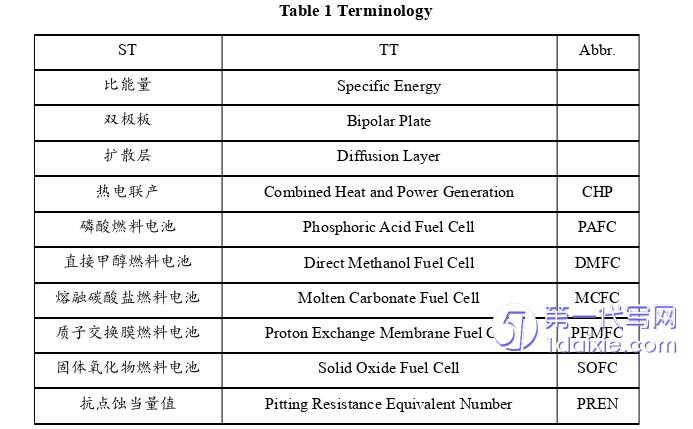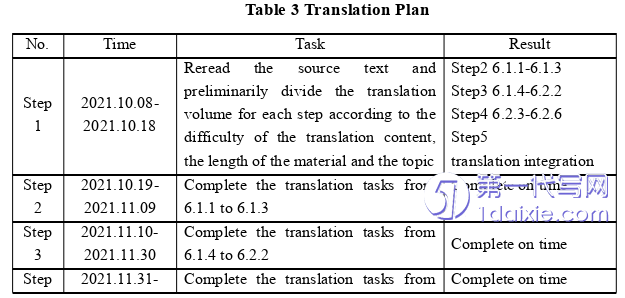本文是一篇英语论文,该报告旨在通过卡特福德的翻译转换理论指导《燃料电池》的中译英研究,以源文本词汇、句式层面的分析为突破口,重点研究层次转换和范畴转换具体应用在科技文本翻译实践中不同转换方式的可行性和有效性以及如何利用该理论克服翻译过程中遇到的词汇、短语、句子等不同层面的障碍。
1.Task Description
1.1 Introduction of Translation Task

Power Battery Technology and Application(first edition),compiled by Hu Xinguo andetc.(2009),consists of 6 chapters,which introduce different types of power batteries in detail:Introduction of Power Battery,Lead-Acid Battery,Alkaline Battery,Lithium-Ion Battery,Zinc-Air Battery,Fuel Cells.These chapters,relatively independent but interconnected,collectively explain the power battery technology and its application.The book fully reflectsthe latest achievements in domestic and international research and development of powerbatteries,and is widely used to promote the development of China’s electric vehicle industry.Therefore,its publication has economic and strategic significance.Translation material isexcerpted from the first two sections of Chapter 6 Fuel Cells of this book with over 20,000words.The first subsection introduces the overview,classification,characteristics,development and current situation of fuel cells,while the second subsection discusses thestructure and working principle of fuel cells,bipolar plate,and catalyst,proton exchangemembrane,membrane electrode assembly and manufacturing process.
As the translation material has to be closely related to science and technology,automobiles and mechanical engineering,etc.,Fuel Cells,downloaded from the Internetduring the author’s professional practice(July 5,2021 to January 20,2022)in LiuGongMachinery Co.,Ltd,is chosen based upon its belonging to sci-tech texts for its lexical andsyntactic features:lots of technical words and abbreviations;multiple non-subject sentencesand complex sentences.Further,given that the sci-tech texts underline the expressiveness ofmeaning to achieve information transfer,the source text is also classified as informative text.These characteristics require the translator to be devoted to bringing a concise,accurate andobjective target text.
1.2 Background of Translation Task
As the science and technology has grown by leaps and bounds in the 21st century,whileseeking development,more attentions are paid to ecological benefits on account of moreprominent side effects of such rapid development:exhausting resources and environmentalcrisis that cannot be ignored.According to the Global Mining Development Report 2020-2021,total energy consumption has fallen by 4.5%,and consumption of new energy minerals hasincreased apace(Xia Peng&Ren Shoumai,2021).Climate change also drives human towardslow-carbon or carbon-free ways of working and living.As a result,many countries havedevoted themselves to the research and development and utilization of new energy in order toachieve a win-win situation of energy conservation and environmental protection and promoteeconomic development.As the fourth type of power generation technology,fuel cells havebecome a hot topic in new energy research and development at home and abroad due to theiradvantages of free pollutant emission,low noise,high utilization rate,simple and easyoperation,and low maintenance requirements.
Sci-tech texts are characterized by its“appropriateness,balance,brevity,consistency,unity,precision,control and visual aids,etc.”(Dai Weihua,1986:6).The material of FuelCells belongs to typical sci-tech texts,thus it has the general characteristics of sci-tech texts,as well as its own characteristics.The general characteristics of sci-tech texts are reflected inthe following three points:a large number of professional terms or non-technical vocabulary(common words that are given specific meanings in sci-tech texts),multiple non-subjectsentences and complex sentences,coupled with rigorous and logical sentence structure.However,it’s a real pity that the research field of fuel cells and relevant sci-tech texts has beendominated by the English-Chinese translation.That is to say,there are many Chinese versions,Chinese translation studies,but few English versions,English translation studies.It means aserious translation imbalance.Therefore,in view of the wide research field and highapplicability of Catford’s translation shifts theory,which is especially common in thetranslation of English for Science and Technology(EST),the English translation study of suchsci-tech texts as Fuel Cells by combining with this theory can not only effectively solve theproblems encountered in translation at the lexical and syntactic level,but also guide thetranslation work.More importantly,it can also provide ideas for the study of foreigntranslation of such texts,thereby possessing social and academic value on translating Chineseinto foreign languages.
2.Translation Process
2.1 Before-Translation
Sci-tech texts fall into the typical informative texts.“Their translation should convey allthe referential content or conceptual content of the original text.It should be‘plain prose’without nonsense,and if necessary,its explication need to be achieved in expressing themeaning of the original text”(Li Changshuan,2004:66).This requires a concise and precisetranslation,which means that the translators have to shoulder a heavy responsibility in theprocess of translation.For one thing,they should be absolutely loyal to the original author,andnot have any tampering or mistranslation of data,formulas,and especially professional-relatedterms;for another,they should be responsible for their readers.While faithfully conveying theoriginal information,the translators should put emphasis on maintaining the readability andpracticality of the target text.More specifically,they should keep the target language accuratebut not rigid,and adjust the paragraph structure and sentence structure of the source textaccording to the translation demands.All these require the translator to be highly professionaland combine appropriate translation strategies or methods in the proper shifts process toachieve maximum equivalence or correspondence between the target text and the source text.In addition,the problems encountered in the translation project will be demonstrated and thetranslation feedback is used as a criterion to control the whole translation process.
2.2 While-Translation
Puzzling out the original text is the foundation of translation work.The preparationbefore translation allows the translator to have a preliminary understanding of the translationmaterial and provides the basis for translation.In order to improve the quality and efficiencyof translation,and make full use of limited time and existing resources,the translator willcontrol the quality and quantity of translation,analyze and summarize some major translationproblems to prepare for after-translation.
2.2.1 Translation Quality and Quantity Control
To successfully complete the task of translating more than 20,000 words within therequired time,it is particularly important to formulate a practical translation plan.In order toensure the smooth implementation of the translation plan,the translator plans to complete theinitial English version within 3 months after the translation material is selected(This Englishversion will be further proofread and revised as shown in the after-translation).At the sametime,the translator translates contents of same topic in the translation material together,thereby improving the coherence and smoothness of the translation.Further,in each step of thetranslation plan,the translator schedules enough time to complete the translation task on time.In this way,that the amount of translation should be completed per day at each step can beadjusted flexibly.The specific translation plan is as follows:

3.Translation Theory.............................11
3.1 Catford’s Translation Shifts Theory...............................11
3.2 Related Researches of Fuel Cell Translation.............................12
3.3 Applicability of Catford’s Theory in Fuel Cells................................12
4.Case Study.......................................14
4.1 Level Shifts..............................14
4.1.1 Shifts of Tense and Aspect...................................14
4.1.2 Shifts Between Singular and Plural Forms.........................15
5.Conclusion...................................27
5.1 Findings.............................................27
5.2 Limitations and Suggestions...................................28
4.Case Study
4.1 Level Shifts
The so-called level shifts refer to“a source-language item at one linguistic level has atarget-language translation equivalent component at a different level”(Mu Lei,1991:85).Thatis,what is grammatically expressed in one language is expressed lexically in another language.Chinese grammar is characterized by covertness,while English grammar is overtness.Covertness is reflected in the fact that the part of speech has nothing to do with themorphology,the grammatical function of words is not easy to distinguish,and tense,tone andvoice are often included in sentences without obvious symbols,and overtness is embodied inthe fact that the part of speech of words can be identified by the morphology(Chen Hongwei,1995:152).This difference makes the conveying of the source-language information can berealized only through the change of the tense and the singular and plural in the level shiftswhen translating sci-tech texts from Chinese to English.
4.1.1 Shifts of Tense and Aspect
In terms of strategies for C-E translation of sci-tech texts,Hu Rongrong and Li Suqionghold that“proper voice conversion is an important means of effective translation,andcompared with other genres,the passive voice in sci-tech texts occupies a large proportion”(2015:91).In translation material Fuel Cells,the dominant voice is active voice influenced byimplicit passive voice in Chinese with frequent ellipsis,so,the Chinese active voice should beconverted into passive voice in most cases to make the statement objective and the mode ofspeech formal.This conversion is exactly one embodiment of structure shifts.
5.Conclusion
5.1 Findings
The purpose of using translation shifts theory is to help translation and improve thetranslation quality instead of shifting for the sake of shifts,otherwise the English version willbe boring and the translation shifts will lose its original meaning.It’s only“according to localconditions”that can we get a“living”translation.Therefore,it’s of vital importance for thetranslator to stay the“nature”of the original in the version so as to make one target readerpossess the same feelings like the source audience.At the same time,the translator should bearin mind that if the equivalent effect is to be achieved,the priority must be given to thecorrespondence in meaning rather than correspondence in style(Munday,2008:43).It’s alsoworth mentioning that the degree of translator’s invisibility determines the visibility of theoriginal author or meaning of the source text(Venuti,1994:1-2).There is no doubt that thetranslator has spared no effort in the whole process of translation practice to achieve thisequivalence and preserve the natural properties of the source text,so many meaningfuldiscoveries have been made.
First,as for translation materials,in the process of translating,the translator firstly has asystematic understanding of the characteristics of sci-tech texts,especially those related tonew energy,including their style,rhetorical and linguistic languages and so on.Then,thetranslator has mastered a large number of technical terms and unique expressions related tofuel cell,and also has a preliminary understanding of this kind of new energy,which hasbroadened the knowledge domain largely.Moreover,this translation practice has alsodeepened the author’s understanding of Catford’s translation theory,and the theory andpractice can be flexibly combined to improve the translation level and translation quality onthe basis of truly appreciating the different shifting methods at each level.
reference(omitted)
